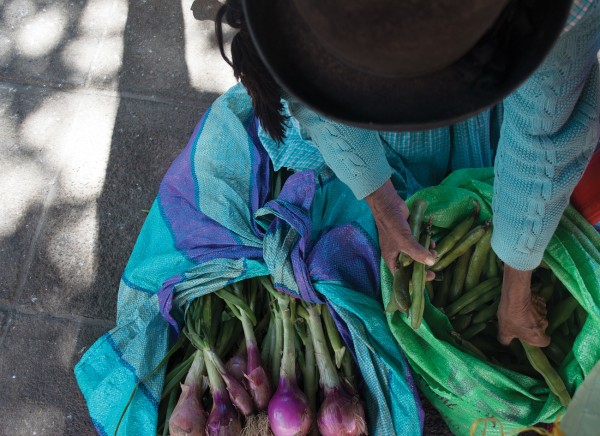Healing Spaces

21 Apr, 2016 | Elsemieke de Boer
Local Produce Feeds the Urban Throngs
Photo: Elsemieke de Boer
On the outskirts of El Alto, peace is found when entering Doña Berta’s carpa solar, or greenhouse, with an abundance of vegetables. It is humid and smells fresh. For a moment one forgets the dusty streets outside. All manner of produce grows here despite being 4100 metres above sea level: there are little green bell peppers, parsley, spinach, baby lettuce, cabbage and much more. The sweet cherry tomatoes are Doña Berta´s favourites. She carefully collects a handful of vegetables and we head out before the chickens can get in.
Doña Berta’s greenhouse is part of a smart solution to today’s global urban challenges. The rapid urbanization rates of the last decades, especially in the Global South, have given cities little time to adapt to the large amount of new urban dwellers. Here in El Alto residents can face difficulties in meeting basic needs around issues of food security, income, social well-being and environmental sustainability. Believe it or not, urban gardens like Doña Berta’s provide solutions to all of these challenges. It is a healing space within the city.
Doña Berta planted the first seeds in her garden in El Alto 15 years ago. With help of an NGO she was able to gain agricultural knowledge, something she was missing before. Though many alteños are rural migrants and therefore have a strong relationship with the countryside and agricultural living, many like her simply do not. But that does not stop these residents from pursuing agriculture, says Katyussa Veiga, project leader of Eco Tambo, a weekly organized ecological urban farmers’ market in La Paz’s Plaza Lira. ‘Although some do not have agricultural knowledge, many learn very fast because they have the imagination,’ she says.
The main benefit of Doña Berta’s garden is secure access to healthy and fresh food. This was particularly important when her children were young. Good nutrition can be a problem within the La Paz–El Alto metropolitan area because many people don’t know much about healthy nutrition and don’t have the means to buy healthy products. Furthermore, most products sold in the city are produced far away, losing freshness after days in transit to the local markets. And for Doña Berta, being able to live off her own garden protects her against rising food prices, enabling her to save money and purchase other necessities.
Doña Berta sells her surplus crops at local markets and to restaurants and families. On Saturdays, a number of urban farmers gather at the Eco Tambo market. In addition to selling their foodstuffs, the vendedores use the market as a meeting point for maintaining their network, sharing experiences and negotiating exchanges. ‘Each urban farmer specializes in a certain type of products,’ Veiga explains. ‘This large variety of products has the advantage that they can buy products from each other, or exchange products amongst themselves when the market ends.’
The majority of the urban farmers at Plaza Lira are women. The fact that they are producers themselves, run their own business and maintain a large social network has given them stronger positions within their families, their neighbourhoods and also the city. ‘They are important leaders and innovators within the community,’ says Veiga.
Although Doña Berta’s garden seems a promising initiative, these urban gardens face challenges too. ‘There is a lack of understanding of the benefits of ecological products,’ Doña Berta says. ‘For example, people do not understand the crucial difference between the use of chemical and natural pesticides.’
Fabrizio Uscamayta, another project leader of Eco Tambo, also stresses some improvements. ‘Just two months ago a new law regarding the promotion of healthy nutrition got approved,’ he says. ‘This has been the first acknowledgement in the country that we are not eating healthy.’ This law seeks to promote healthier nutrition of the Bolivian people by establishing guidelines and mechanisms. Health, according to the Bolivian government, is a human right and contributes to vivir bien.
Climate change poses a major threat to livelihoods in Bolivia, but urban gardens might provide solutions. ‘This area has been pointed out as extremely vulnerable to future climate change,’ says Uscamayta. The region’s altitude and geographical characteristics pose challenges to the biodiversity, water and ground quality, glaciers and agriculture in the region. ‘It will be difficult to adapt to, but urban gardens could form a very interesting answer,’ says Uscamayta. Despite the altitude and climate change, Doña Berta still manages to grow her cherry tomatoes because her urban garden has its own sustainable micro-climate and maintains fertile soil and ideal growing conditions.
These urban gardens are also known for their therapeutic powers – they are spaces where tranquility can be found. The area where Doña Berta lives has very few trees and the low oxygen level poses an issue to her health. ‘The greenhouses are full of green and contain high oxygen levels; they are places of peace and silence to the women,’ says Veiga.
In many ways urban gardens are healing spaces within cities. They provide economic, social and environmental solutions to today’s global urban challenges. Doña Berta’s garden is a great example from which others can learn. When leaving El Alto, Doña Berta asks me at least 10 times, ‘My carpa solar has an abundance of vegetables, right?’ I assure her it is a beautiful place she can be very proud of.







